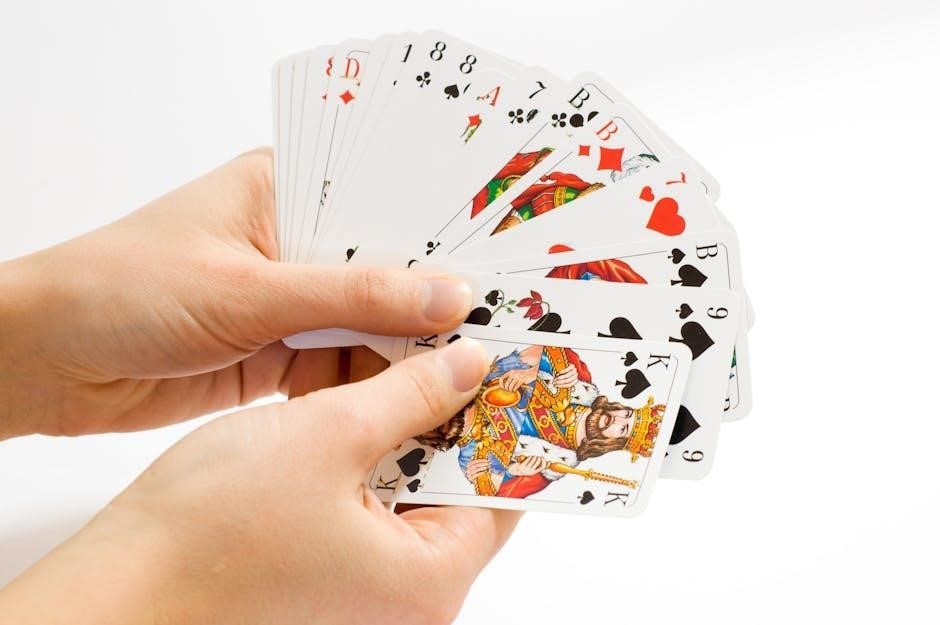1.1 What is a Blackjack Strategy Chart?
A Blackjack Strategy Chart is a visual guide outlining optimal decisions for every possible hand in a 6-deck game, helping players maximize their chances of winning.
1.2 Importance of Using a Strategy Chart in Blackjack
Using a strategy chart ensures players make mathematically correct decisions, reducing the house edge and improving long-term results in both online and casino blackjack games.
1.3 How to Read a Blackjack Strategy Chart
To read the chart, match your hand (listed vertically) with the dealer’s upcard (listed horizontally). Symbols like H (Hit) and S (Stand) guide your actions.
A Blackjack Strategy Chart is a visual guide that provides optimal decisions for every possible hand in a 6-deck game. It helps players determine when to hit, stand, double down, or split based on their hand and the dealer’s upcard. Available as a PDF, it’s a convenient tool for improving gameplay and increasing chances of winning in blackjack.
Using a Blackjack Strategy Chart is crucial for minimizing the house edge and maximizing winning potential. It provides players with a clear, data-driven approach to decision-making, ensuring optimal plays for every possible hand. By following the chart, players can avoid costly mistakes and make consistent, mathematically sound decisions, tailored to the specific rules of a 6-deck game, such as dealer standing on soft 17. This tool is essential for both beginners and experienced players aiming to improve their gameplay.
A Blackjack Strategy Chart is a grid that maps your hand to the dealer’s upcard, providing clear actions like Hit (H), Stand (S), or Double Down (D). Find your hand along the left and the dealer’s upcard at the top. Match them to find the optimal move. Abbreviations guide actions, ensuring you make mathematically correct decisions. This visual tool simplifies complex strategies, helping players of all skill levels make informed choices during gameplay.

Understanding the 6-Deck Blackjack Game
The 6-deck blackjack game is the most common casino variant, using six standard decks. It offers a balanced mix of strategy and odds, making it a player favorite.
2.1 What Makes 6-Deck Blackjack Different?
The 6-deck blackjack game stands out due to its use of six standard decks, which increases the total number of cards and slightly raises the house edge compared to single-deck games. This variation also requires specific strategy adjustments, such as handling soft 17 and doubling down rules, which differ from other deck configurations. The larger deck count makes card counting less effective and alters the probability of certain outcomes, making it a unique challenge for players.
2.2 Rules of 6-Deck Blackjack
In 6-deck blackjack, the dealer typically stands on soft 17, and doubling down after splitting is allowed. Surrender is not permitted, and the game uses six standard decks. The dealer’s actions are predetermined, ensuring consistency. Players can double down on any two-card hand, and splitting is allowed on identical cards. Insurance bets are optional, but basic strategy advises against them. These rules slightly increase the house edge compared to single-deck games.
2.3 House Edge in 6-Deck Blackjack
The house edge in a 6-deck blackjack game is approximately 0.5%, based on standard rules where the dealer stands on soft 17. This edge increases slightly if the dealer hits on soft 17. The multi-deck format introduces more unpredictability, but using a strategy chart can minimize this advantage. Specific rules, such as double after split and no surrender, also influence the edge. Despite this, 6-deck blackjack remains a popular choice due to its balanced gameplay and strategy depth.
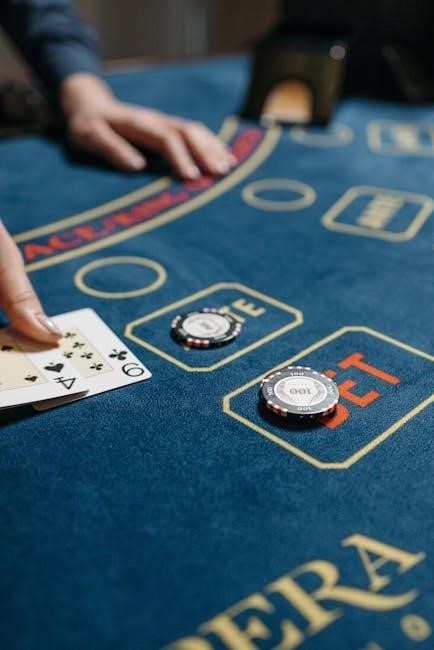
Key Elements of a 6-Deck Blackjack Strategy Chart
A 6-deck blackjack strategy chart outlines decisions for hard and soft hands, emphasizing hit, stand, double down, and split actions based on the dealer’s upcard.
3.1 Hit, Stand, Double Down, and Split Decisions
The 6-deck strategy chart provides clear guidance on when to hit, stand, double down, or split. Hitting is advised when your hand value is low, while standing is best with strong hands; Doubling down is optimal with hands like 10 or 11, and splitting is recommended for pairs like 8s or As. These decisions minimize losses and maximize wins based on the dealer’s upcard.
3.2 Understanding Soft Hands and Hard Hands
In Blackjack, hands are categorized as soft or hard. Soft hands contain an Ace valued at 11, offering flexibility without busting. Hard hands lack an Ace or have it counted as 1, making them less flexible. Understanding the difference is crucial, as strategies vary significantly. For example, hitting on a soft 17 is often advised, while standing on a hard 17 is typically better. This distinction is key to making optimal decisions based on the dealer’s upcard.
3.3 The Role of the Dealer’s Upcard
The dealer’s upcard significantly influences your strategy in Blackjack. A weak dealer upcard (2-6) often calls for aggression, such as doubling down or splitting, as it increases the likelihood of a favorable outcome. Conversely, a strong upcard (7-Ace) may prompt more cautious decisions like standing or hitting. This dynamic is central to the strategy chart, helping players adapt their moves based on the dealer’s visible card to maximize their chances of winning.
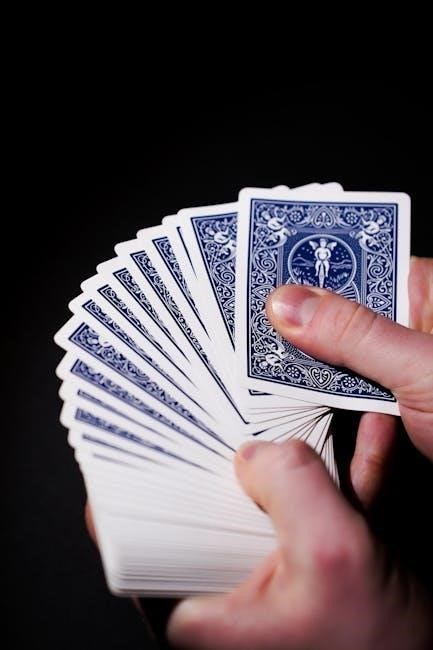
Basic Strategy Principles
Basic strategy principles provide a mathematical approach to maximize winning potential by guiding decisions like hitting, standing, doubling, and splitting, reducing the house edge effectively.
4.1 When to Hit in 6-Deck Blackjack
In 6-deck blackjack, you should hit when your hand is weak, such as 8 or less, or when the dealer’s upcard is strong (7-Ace). Hitting allows you to improve your hand without risking a bust. For soft hands (e.g., Ace-3), hitting is optimal if your total is 17 or less. Always hit on a hard 12 if the dealer shows a 2 or 3, as standing risks losing to a higher total. Use the chart to confirm when hitting maximizes your chances of winning.
4.2 When to Stand in 6-Deck Blackjack
In a 6-deck game, stand when your hand is strong, such as 17 or higher, to avoid busting. Stand on 12-16 if the dealer’s upcard is weak (2-6). With soft hands (e.g., Ace-6), stand on 18 or higher. Avoid standing on soft 17 unless the dealer’s upcard is weak. Use the strategy chart to confirm optimal standing decisions and minimize losses. Standing ensures you avoid unnecessary risks when your hand is already competitive.
4.3 When to Double Down in 6-Deck Blackjack
Double down when your hand has a high probability of improving with one additional card. Ideal situations include having 11 and the dealer shows 2-10, or 10 with the dealer showing 9 or lower. With soft hands like Ace-5 or Ace-6, double if the dealer’s upcard is weak. Avoid doubling when the dealer’s upcard is strong (Ace or 7+). Use the strategy chart to identify precise double-down opportunities and maximize potential wins.
4.4 When to Split in 6-Deck Blackjack
Splitting is advantageous when you have pairs like Aces or 8s, as it increases your chances of forming strong hands. Always split 2s, 3s, or 7s if the dealer’s upcard is weak (4-7). Split 6s when the dealer shows 2-6 and 9s when the dealer shows 2-6 or 8. Avoid splitting 4s, 5s, or face cards unless the dealer’s upcard is unfavorable. Use the strategy chart to determine the best split decisions based on the dealer’s upcard.

The 6-Deck Blackjack Strategy Chart PDF
The 6-Deck Blackjack Strategy Chart PDF is a concise, printable guide that outlines optimal decisions for every hand in a 6-deck game, ensuring quick reference during play.
5.1 Benefits of Using a PDF Chart
A PDF chart offers portability, allowing you to access it anytime, anywhere, even offline. Its clear layout ensures readability, making quick decisions easier during games. Printing it enhances convenience, letting you reference it effortlessly. PDFs are also environmentally friendly and easily sharable, making them a practical tool for improving your blackjack strategy. These benefits make a PDF chart indispensable for both novice and experienced players aiming to refine their skills.
5.2 How to Download and Print the Chart
To download the 6-deck blackjack strategy chart, visit a trusted website offering free PDF resources. Click the download link, save the file, and open it using a PDF viewer. For printing, ensure your printer settings match the chart’s dimensions. Print on high-quality paper for clarity. This convenient format allows you to reference the chart anytime, making it an essential tool for improving your gameplay and decision-making at the table.
5.3 Using the Chart During Gameplay
During gameplay, refer to the chart by matching your hand and the dealer’s upcard. Quickly locate the corresponding decision (Hit, Stand, Double Down, or Split) to make optimal moves. Keeping the chart handy ensures consistent strategy application, reducing errors and improving your chances of winning. Regular use reinforces basic strategy principles, helping you develop muscle memory for common scenarios in 6-deck blackjack.
Advanced Blackjack Strategy
Advanced strategies involve card counting, adjusting decisions based on deck composition, and mastering techniques like doubling down and splitting pairs optimally in 6-deck blackjack.
6.1 Card Counting in 6-Deck Blackjack
Card counting is an advanced technique used to track the ratio of high to low cards in the deck, giving players an edge. In 6-deck blackjack, this method involves assigning values to cards (e.g., +1 for 2-6, -1 for 10-Ace) and adjusting bets and decisions based on the running count. This strategy helps players anticipate favorable situations and make optimal moves, reducing the house edge significantly over time with consistent practice.
6.2 Adjusting Strategy Based on Deck Composition
Adjusting strategy based on deck composition is crucial in 6-deck blackjack. As cards are dealt, the ratio of high to low cards changes, influencing optimal decisions. Players use techniques like card counting to track this. A higher concentration of high cards favors the player, while more low cards benefit the dealer. By adapting decisions such as hitting, standing, or doubling down, players can exploit favorable deck compositions effectively, maximizing their edge.
6.3 Advanced Techniques for Experienced Players
Experienced players can enhance their gameplay with advanced techniques like card counting systems and shuffle tracking. These methods refine basic strategy by adjusting decisions based on deck composition. Advanced players also master techniques such as Wonging and back-counting to optimize their play. Additionally, understanding the impact of deck penetration and utilizing side bets strategically can further improve their overall performance in 6-deck blackjack games.

Common Mistakes to Avoid
Common mistakes include ignoring basic strategy, misunderstanding soft 17 rules, and failing to adapt to the number of decks. These errors increase the house edge significantly.
7.1 Ignoring Basic Strategy
Ignoring basic strategy leads to poor decision-making and increased house edge. Players should avoid relying on intuition and instead follow the chart to minimize losses. This ensures optimal decisions for every hand combination, improving overall performance. By ignoring strategy, players risk falling into common traps, reducing their chances of long-term success. Consistent adherence is crucial for maximizing potential.
7.2 Misunderstanding Soft 17 Rules
Misunderstanding soft 17 rules can lead to costly mistakes. A soft 17 occurs when a player holds an Ace and a 6, totaling 17. Depending on the casino, the dealer may either stand or hit on soft 17. Ignoring these rules can cause players to make incorrect decisions, such as standing when they should hit or vice versa. Always consult the strategy chart to avoid such errors and optimize your gameplay.
7.3 Not Adapting to the Number of Decks
One common mistake is failing to adjust strategy based on the number of decks. In a 6-deck game, the probabilities differ from single or double-deck games. Ignoring this can lead to suboptimal decisions, such as splitting or doubling down inappropriately. Always use a strategy chart tailored to the specific number of decks being used to ensure accurate and effective gameplay decisions.
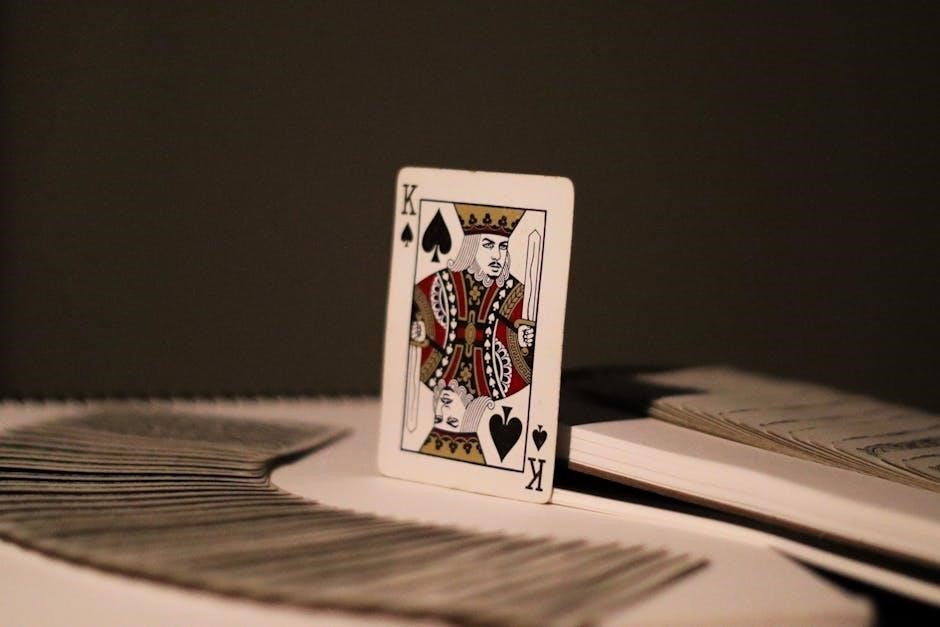
Comparing 6-Deck to Other Blackjack Variations
6-deck blackjack differs from single-deck, double-deck, and European/American versions in rules and strategy. Each variation requires tailored approaches to optimize gameplay and maximize winning chances effectively.
8.1 Single-Deck vs. 6-Deck Blackjack
Single-deck and 6-deck blackjack differ significantly in strategy and house edge. Single-deck games offer a lower house edge but often come with less favorable rules, such as dealers hitting on soft 17. In contrast, 6-deck games provide more standardized rules and a higher card variety, making strategy charts more accessible. The 6-deck version is widely popular in casinos due to its balanced gameplay and consistent probability calculations.
- Single-deck games have faster-changing deck composition.
- 6-deck games offer more stable strategy applications.
- Card counting is easier in single-deck but risky in 6-deck.
Players often prefer 6-deck for its predictable nature and ease of learning.
8.2 Double-Deck vs. 6-Deck Blackjack
Double-deck and 6-deck blackjack games differ in strategy and house edge. Double-deck games offer faster deck penetration, making card counting more effective, but with higher volatility. The 6-deck version provides a lower house edge and more stable gameplay, making it ideal for beginners. Strategy charts for 6-deck games are widely available, while double-deck requires adjustments. Players often prefer 6-deck for its simplicity and consistent odds.
- Double-deck has fewer cards, changing deck composition quickly.
- 6-deck offers more predictable outcomes and easier strategy.
8.4 European vs. American Blackjack
European and American Blackjack differ in rules and strategy. European Blackjack typically uses 2-6 decks, while American often uses 6-8. In European Blackjack, the dealer doesn’t check for a blackjack, and doubling down is restricted to specific hand values. American Blackjack allows surrender and has more flexible doubling rules. The hole card rule in American games impacts strategy, while European games focus on predetermined dealer actions. These variations influence the house edge and optimal strategies for players.
- European Blackjack often has stricter rules for doubling down.
- American Blackjack includes surrender and hole card options.
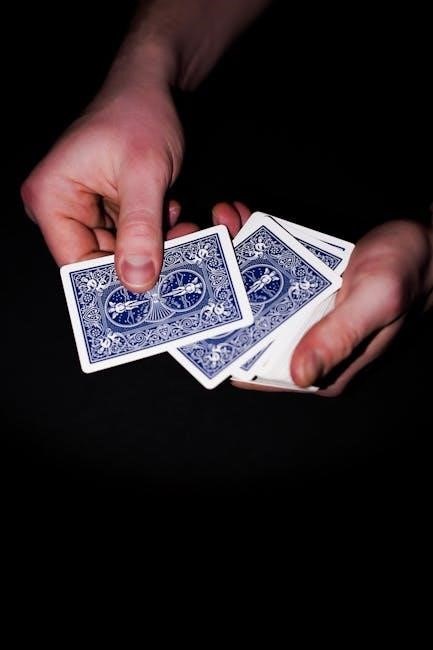
The Impact of Dealer Rules on Strategy
Dealer rules significantly impact strategy in 6-deck blackjack. Whether dealers hit or stand on soft 17, double after split options, and surrender rules all shape the strategy chart.
9.1 Dealer Stands on Soft 17 vs. Hits on Soft 17
In 6-deck blackjack, whether the dealer stands or hits on soft 17 drastically affects strategy. If the dealer stands on soft 17, players benefit from increased odds, as the dealer’s rigid rule minimizes their advantage. Conversely, if the dealer hits on soft 17, the house edge rises, requiring players to adjust by hitting more frequently on certain hands, like 17, to avoid losing to a potential dealer improvement. This rule difference significantly alters optimal decisions, making strategy charts rule-specific.
9.2 Double After Split Rules
In 6-deck blackjack, the “Double After Split” rule significantly impacts strategy. If allowed, players can double down after splitting a pair, maximizing potential wins on strong hands. Conversely, if doubling after splitting is prohibited, players lose this advantageous option, which can limit their ability to capitalize on favorable situations. This rule variation is critical in optimizing decisions, as it directly influences the house edge and player strategy in different game scenarios.
9.3 Surrender and Insurance Bets
Surrender and insurance bets are advanced options in blackjack that can significantly impact strategy. Surrender allows players to fold their hand early, losing half their bet, while insurance bets wager on the dealer having a blackjack. Both options must be used judiciously, as they can either reduce losses or increase the house edge. Understanding when to surrender or take insurance is crucial for optimizing your 6-deck blackjack strategy and improving overall performance at the table.
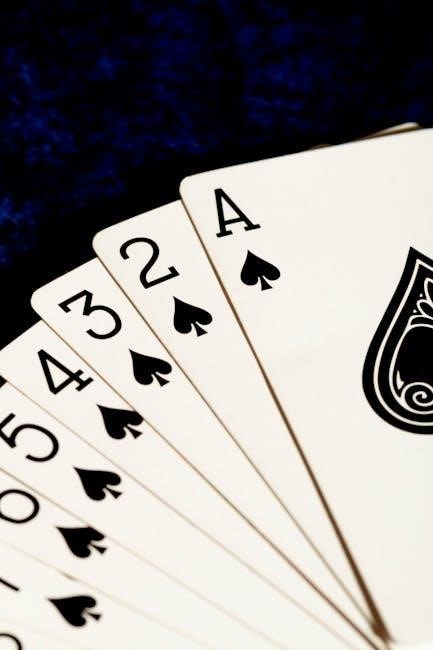
Practicing with the 6-Deck Strategy Chart
Practicing with the 6-deck strategy chart involves using online simulators, keeping the chart handy during play, and continuously refining your decisions to master optimal blackjack strategies effectively.
10.1 Using Online Blackjack Simulators
Online blackjack simulators provide a risk-free environment to practice and refine your strategy. They allow you to apply the 6-deck strategy chart in real-time, helping you understand how to make optimal decisions. Many simulators offer customizable rules, such as dealer stands on soft 17, allowing you to tailor the experience to your needs. By consistently using these tools, you can identify and correct mistakes, improving your skills and confidence in applying the strategy effectively. This practice is essential for mastering the 6-deck blackjack strategy chart and enhancing your overall gameplay.
10.2 Keeping the Chart Handy During Play
Keeping the 6-deck blackjack strategy chart accessible during play is crucial for consistent decision-making. Whether as a printed PDF or a digital version on your device, having it nearby ensures you can quickly reference optimal moves. This helps avoid mistakes and maintains adherence to basic strategy, especially under pressure. Regular use reinforces your knowledge, making it easier to internalize the chart over time and improve your overall performance in the game.
10.3 Continuous Learning and Improvement
Continuous learning and improvement are essential for mastering 6-deck blackjack. Regularly review the strategy chart to reinforce decisions and adapt to new scenarios. Track your progress, analyze mistakes, and explore advanced techniques to refine your gameplay. By staying committed to learning, you’ll enhance your skills and maintain a competitive edge, ensuring long-term success in both online and casino environments.
Consistency and discipline are key to long-term success in blackjack. By mastering the 6-deck strategy chart, you maximize your chances of winning and minimize losses over time.
This guide provides a solid foundation, but continuous practice and adaptation will elevate your gameplay to the next level.
11.1 The Importance of Consistency
Consistency is crucial in blackjack, as it minimizes errors and maximizes long-term results. By adhering to the 6-deck strategy chart, players ensure optimal decisions, reducing the house edge. Consistency also builds discipline, preventing emotional or impulsive choices that can lead to losses. Over time, this approach fosters confidence and improves overall performance, making it a cornerstone of a winning blackjack strategy.
11.2 Maximizing Your Chances of Winning
To maximize your chances of winning in blackjack, combine the 6-deck strategy chart with optimal betting and bankroll management. Consistently applying the chart reduces the house edge, while adapting to rule variations ensures tailored decisions. Avoid common mistakes, such as ignoring soft 17 rules or splitting incorrectly. By mastering these elements, you enhance your long-term profitability and improve overall performance at the table.
11.3 Final Thoughts on 6-Deck Blackjack Strategy
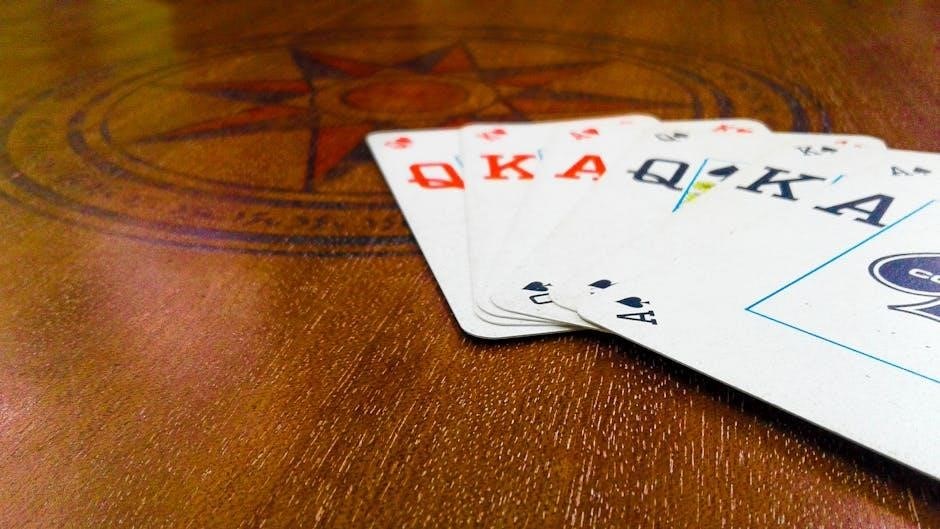
Additional Resources
Explore recommended reading, online forums, and video tutorials for deeper insights into 6-deck blackjack strategy. These resources offer advanced tips and community discussions to enhance your gameplay.
12.1 Recommended Reading
For in-depth understanding, explore books like The Theory of Blackjack and Blackjack Bluebook II. Online resources such as Blackjack Strategy Chart PDFs and detailed guides provide comprehensive insights. Websites specializing in casino strategies offer tutorials and expert advice. These materials cover basic strategy, card counting, and advanced techniques, ensuring players at all levels can refine their skills and master 6-deck blackjack effectively.
12.2 Online Communities and Forums
Engage with online communities like Blackjack Forum and Reddit’s r/blackjack for discussions and resources. These platforms offer insights from experienced players, strategy debates, and reviews of tools like the 6-deck PDF chart. Members often share tips, personal strategies, and updates on casino rules, fostering a collaborative environment to enhance your blackjack knowledge and improve gameplay through shared experiences and expert advice.
12.3 Video Tutorials and Guides
Video tutorials provide a dynamic way to learn 6-deck blackjack strategies. Platforms like YouTube and Blackjack Academy offer step-by-step guides on using strategy charts, explaining concepts like soft hands and doubling down. These videos often include real-game examples, making complex strategies easier to understand. Additionally, channels dedicated to casino gaming share tips on optimizing your gameplay with the 6-deck PDF chart, ensuring you apply the best tactics effectively during actual games. Always check for updated content to stay informed about rule changes and advanced techniques.
